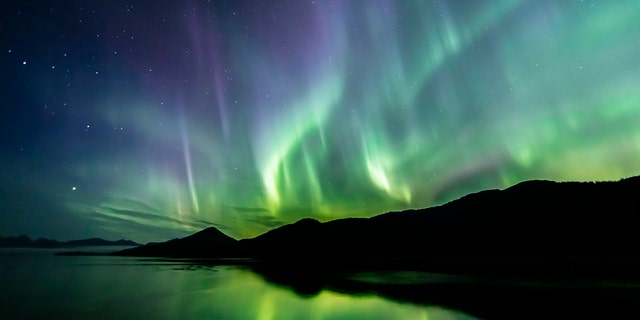
NEWYou can now listen to Fox News articles!
Special elections in August for Alaska’s at-large House seat usually aren’t the best metric to help predict major, domestic political trends.
Alaska is a massive state with a tiny voting population. Things impact Alaska differently than they do the rest of the U.S. When it comes to Alaska, it’s not on par with the swing states of “Arizona” or “Pennsylvania” — purple states where the political winds bellow in both directions.
But the northern political lights of Alaska could illuminate an important phenomenon to watch for in the midterms this fall.
Alaska voters just tapped Rep.-elect Mary Peltola, D-Alaska, to succeed the late Rep. Don Young, R-Alaska, for the remainder of his term. Young died earlier this year flying back to the state. Young held the seat since winning a special election himself in 1973 — and flipping the seat from Democratic to Republican. Peltola bested 2008 Republican Vice Presidential nominee Sarah Palin and GOPer Nick Begich III. Begich is the grandson of late Rep. Nick Begich, D-Alaska, who died in a plane crash in 1972 and was succeeded by Young. Former Sen. Mark Begich, D-Alaska, is the uncle of Nick Begich III.
REPORTER’S NOTEBOOK: WHO’S REALLY ON THE BALLOT IN NOVEMBER?
In the special election, Palin finished second. Begich III finished third.
Alaska features a new system to elect its lawmakers. It’s called “ranked-choice voting.” If a particular candidate fails to score 50.1 percent of the tally, voters then “rank” their other choices. The candidate who voters listed as “second” on the most ballots is rewarded with a boost. Those “second place votes” are essentially treated as “first place” votes. In essence, this creates an “instant runoff” and voters don’t have to return to the polls a second tine.
The second-place votes help decide the winner.
Alaska voters implemented ranked-choice voting by a narrow margin in 2020. Maine also put ranked-choice voting into effect in recent years.
Democrats immediately seized on the narrative that the party was suddenly blunting a “red wave.” Democrats unexpectedly won a special election in upstate New York in August. Then Peltola won in a state which former President Donald Trump carried by 14 points in 2016 and 10 points in 2020.
An omen for the fall? Maybe. But that is not the canary in the coal mine (caribou on the tundra?) which we’re latching onto here.
Republicans argued voters didn’t understand ranked-choice voting. They point out that after the first round, Peltola only scored about 40 percent of the vote. Yet Republicans Palin and Begich commanded a combined 59 percent of the vote.
But, here’s another data point from the Alaska House contest which deserves attention.

Alaska voters tapped Rep.-elect Mary Peltola, D-Alaska, to succeed the late Rep. Don Young, R-Alaska, for the remainder of his term. (Ash Adams for The Washington Post via Getty Images)
DEMOCRAT MARY PELTOLA WINS ALASKA SPECIAL ELECTION TO FILL REMAINDER OF REP. DON YOUNG’S TERM
Peltola won. Palin finished second. But the radioactive Palin was not the second choice of many Republican voters who cast their ballots for Begich. In fact, those GOP voters viewed Palin as so controversial that they picked the Democrat Peltola as their second choice over Palin.
That was the factor which propelled Peltola to victory in what has been a Republican seat for nearly five decades.
The big takeaway from Alaska: Sarah Palin and other GOP candidates, who are too controversial or espouse views too closely aligned with former President Trump, stumble at the polls.
Republicans may have been able to hold this seat with someone other than Sarah Palin on the ballot. By the same token, Palin siphoned away just enough conservative support among Republicans to slip past Begich. That’s why Democrats won the seat.

Sarah Palin lost a special election for the sole U.S. House seat in Alaska. (AP Photo/Mark Thiessen, File)
Palin is running in the general election for the full term this fall. But Alaska Survey Research polled Palin’s popularity with Alaskans at just 31 percent. That’s well below the rankings of President Biden and former President Trump. That could mean Palin is unelectable. And it’s possible Republicans could coalesce around Begich in the general election.
In an interview, Palin characterized ranked-choice voting as a “newfangled, cockamamie system” — even though Alaska voters approved the electoral method in a statewide ballot.
It’s possible all of this says much more about Palin than GOP candidates at large. But the signal from Alaska could indicate problems Republicans have with a host of other candidates running for the Senate and in gubernatorial races this fall.
FORMER ALASKA GOV. SARAH PALIN KNOCKS RANKED-CHOICE VOTING AFTER ELECTION LOSS
Senate Minority Leader Mitch McConnell, R-Ky., has expressed concern about the viability of some Republicans on the ballot for the Senate this fall.
“Candidate quality has a lot to do with the outcome,” said McConnell in August. “I think there’s probably a greater likelihood the House flips than the Senate.”
McConnell is teeing up a defense should sub-par candidates prevent Republicans from claiming the Senate. But McConnell has also inoculated himself from criticism that his negative remarks about candidates also don’t backfire.
GOP Senate nominees Mehmet Oz from Pennsylvania, Herschel Walker from Georgia and Rep. Ted Budd, R-N.C., were part of a candidate event McConnell hosted. A political action committee linked to McConnell has reserved just under $100 million in campaign cash to be spent in Senate contests in those three states alone.

The political dynamics of Alaska could shed a light on a political trend to watch in the Lower 48. (iStock)
But McConnell is a realist. He’s noted how Republicans whiffed in bids to seize control of the Senate in 2010 and 2012 due to inferior GOP candidates.
“How could you screw this up? It’s actually possible,” said McConnell about Republican Senate prospects this fall. “We’ve had some experience with that in the past.”
Purple states like Pennsylvania or Arizona may be hard for damaged candidates to win. It may be more plausible that a more “conventional” Republican could win in those states. That’s especially true if there is an attempt to flip a state like Arizona.
However, one may be able to glean another nugget from the “candidate quality.”
CLICK HERE TO GET THE FOX NEWS APP
Watch to see how controversial Republican candidates perform this fall in battleground races. If those candidates who some have written off as “not ready for primetime” prevail, that could say a lot about former President Trump’s chances in 2024. It may also encourage Republican candidates with similar political silhouettes to run for the House and Senate next time.
That said, Republican candidate quality is one of the biggest issues in this year’s midterm elections. And this may also be one of the few occasions where the political dynamics of Alaska could shed a light on a political trend to watch in the Lower 48.









